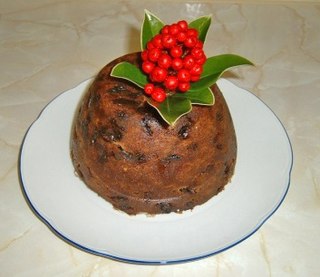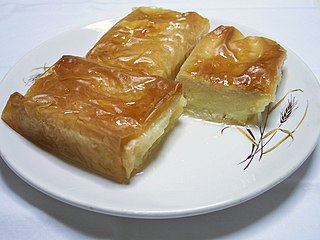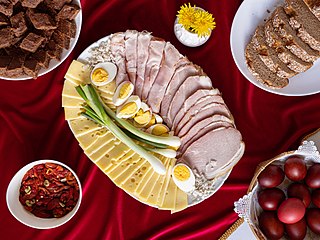
Dessert is a course that concludes a meal. The course consists of sweet foods, such as cake, and possibly a beverage such as dessert wine and liqueur. Some cultures sweeten foods that are more commonly savory to create desserts. In some parts of the world there is no tradition of a dessert course to conclude a meal.

Christmas pudding is sweet, dried-fruit pudding traditionally served as part of Christmas dinner in Britain and other countries to which the tradition has been exported. It has its origins in medieval England, with early recipes making use of dried fruit, suet, breadcrumbs, flour, eggs and spice, along with liquid such as milk or fortified wine. Later, recipes became more elaborate. In 1845, cookery writer Eliza Acton wrote the first recipe for a dish actually called "Christmas pudding".

Cheesecake is a dessert made with a soft fresh cheese, eggs, and sugar. It may have a crust or base made from crushed cookies, graham crackers, pastry, or sometimes sponge cake. Cheesecake may be baked or unbaked, and is usually refrigerated.

Pampúshka is a small savory or sweet yeast-raised bun or doughnut typical for Ukrainian cuisine.

Galaktoboureko is a dessert of custard baked in filo. Lazi Laz böreği is made with a type of pudding called muhallebi instead of semolina custard. It is popular throughout the Balkans and Eastern Mediterranean including Greece, Turkey, and Albania. In Albania it is traditionally prepared during the Orthodox Easter.

Tsoureki also known as Šurēk, Choreg, Chorek or Bsatir, çörək (Azerbaijani), çyrek (Albanian), kozunak, cozonac (Romanian) or paskalya çöreği (Turkish) is a sweet holiday bread made with flour, milk, butter, eggs, and sugar and commonly seasoned with orange zest, mastic resin, or mahlab. Lampropsomo, a variation of tsoureki commonly called "Greek Easter bread," is made by Greek communities during Easter, not only in Greece, but also in other countries with Greek communities. It is also called Armenian Easter bread and gets eaten during Easter in Armenia.

Shakshouka is a Maghrebi dish of eggs poached in a sauce of tomatoes, olive oil, peppers, onion, and garlic, commonly spiced with cumin, paprika and cayenne pepper. According to Joan Nathan, shakshouka originated in Ottoman North Africa in the mid-16th century after tomatoes were introduced to the region by Hernán Cortés as part of the Columbian exchange. Shakshouka is a popular dish throughout the Middle East and North Africa.

Yomari, also called yamari, is a delicacy of the Newar community in Nepal. It is a steamed dumpling that consists of an external covering of rice flour with sweet fillings such as chaku and khuwa. The delicacy plays a very important role in Newa society, and is a key part of the festival of Yomari Punhi. According to some, the triangular shape of the Yamari is a symbolical representation of one half of the Shadkona, the symbol of Saraswati and wisdom.

Fruit soup is a soup prepared using fruit as a primary ingredient, and may be served warm or cold depending on the recipe. Some fruit soups use several varieties of fruit, and alcoholic beverages such as rum, sherry and kirsch may be used. Fruit soup is sometimes served as a dessert.

Potato babka is a savoury dish, popular especially in Belarus and northeastern Poland, where it is known as babka ziemniaczana. It is made from grated potatoes, eggs, onions, and pieces of smoked, boiled or fried bacon and sausage. It is oven-baked in a crock, and often served with a sauce of sour cream and pork flitch. Depending on recipe and cooking method, it may be either a flaky potato pie or a heavy potato pudding.

Carrot pudding is a dish traditional to a wide range of cultures around the world. It can be served either as a savoury pudding or as a sweet dessert.

Black pudding is a distinct regional type of blood sausage originating in the United Kingdom and Ireland. It is made from pork or occasionally beef blood, with pork fat or beef suet, and a cereal, usually oatmeal, oat groats, or barley groats. The high proportion of cereal, along with the use of certain herbs such as pennyroyal, serves to distinguish black pudding from blood sausages eaten in other parts of the world.

Balkan cuisine is a type of regional cuisine that combines characteristics of European cuisine with some of those from Western Asia. It is found in the Balkan Peninsula of Southeast Europe, a region without clear boundaries but which is generally considered to at least include the modern countries of Albania, Bulgaria, Turkey, Romania and Greece and the former Yugoslavia, with the possible exception of Slovenia and northern inland regions of Croatia.
Khanom thian is a type of Thai khanom prepared in the shape of a candle. It originated in northern Thailand, and is used by some people as a ceremonial dish.

Bustrengo is a cake dish in Romagnol and Sammarinese cuisine and a traditional Christmas dish in the Republic of San Marino, in the provinces of Forlì-Cesena and Rimini, which are in Emilia-Romagna and partly in the region of Marche. It is consumed at all times of the year. Ingredients include standard cake ingredients such as flour, leavening, oil or shortening, sugar or honey, etc. along with cornmeal, bread crumbs or stale bread, figs, raisins, diced apples, lemon rind and orange rind. It is typically a dense and moist cake.














